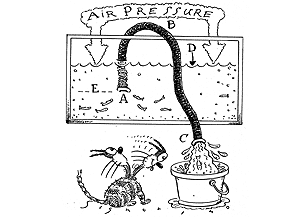I recall burning three or four weeks of a sabbatical getting Saccade.com on the air with Wordpress. So much tweaking…
The Straight Dope: How does a siphon work?
 Last night’s reading reminded me that I have never really been satisfied with my understanding of how siphons work. Apparently I’m not the only one, since there was this interesting exchange on Straight Dope which pointed out some of the disconcerting issues that surround explanations of their actions. I’m still not convinced I have a good understanding of their action. For example, in the cartoon above, it implies that air pressure pushes down on the tank above, but surely it also applies to the water below in the bucket, yes? I’m guess I’m skeptical about this “air pressure” idea. Tom suggested briefly in lunch that as long as the fluid’s vapor pressure was such that the weight of the downward column was insufficient to introduce cavitation, that the siphon action would continue. That sounds more like the truth to me, since it doesn’t rely on any notion of “atmospheric pressure” pushing on things. But I’m still not 100% satisfied with my understanding.
Last night’s reading reminded me that I have never really been satisfied with my understanding of how siphons work. Apparently I’m not the only one, since there was this interesting exchange on Straight Dope which pointed out some of the disconcerting issues that surround explanations of their actions. I’m still not convinced I have a good understanding of their action. For example, in the cartoon above, it implies that air pressure pushes down on the tank above, but surely it also applies to the water below in the bucket, yes? I’m guess I’m skeptical about this “air pressure” idea. Tom suggested briefly in lunch that as long as the fluid’s vapor pressure was such that the weight of the downward column was insufficient to introduce cavitation, that the siphon action would continue. That sounds more like the truth to me, since it doesn’t rely on any notion of “atmospheric pressure” pushing on things. But I’m still not 100% satisfied with my understanding.
via The Straight Dope: How does a siphon work?.
Addendum: Wikipedia has a nice article, including some helpful math.
Comment from Kevin VandeWettering
Time 7/23/2009 at 1:25 am
The motive force of siphon action is gravity. The role of atmospheric pressure is to keep the water cohesive. If you try to create a siphon more than 34 feet high, the water in the pipe will drop to the 34 foot level and the siphon action will stop.
It’s also the reason deep water wells need a pump at the bottom. Removing all the air from a pipe can only raise water 34 feet.